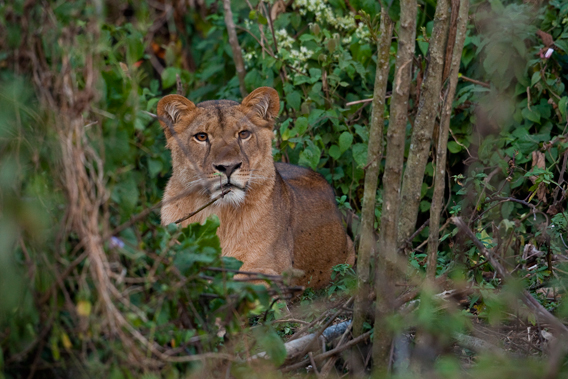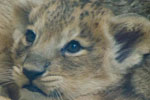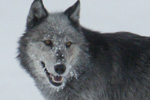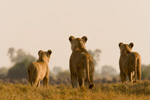
Female lion peers through the thick foliage of a montane rainforest in Ethiopia. Photo by: Bruno D’Amicis/NABU.
Calling the African lion (Panthera leo) the ‘king of the jungle’ is usually a misnomer, as the species is almost always found in savannah or dry forests, but recent photos by the Germany-based Nature and Biodiversity Conservation Union (NABU) document lions in Ethiopian rainforests. Taken in the Kafa Biosphere Reserve, the photos show a female lion hiding out in thick montane jungle.
“We are delighted with this news and look forward to studying these exceptional animals in their unusual habitat,” said NABU’s Vice-President Thomas Tennhardt in a press release. “To manage potential conflict with local communities, NABU will set up a dedicated conservation fund.” NABU has been working in the region since 2006.
Long known to locals, the lions are actually thought not to be permanent residents, but possibly passing through Kafa Biosphere Reserve in the dry season.
Kafa Biosphere Reserve covers 760,000 hectares of montane rainforest and preserves the last place on Earth where wild coffee (Coffea arabica) still grows naturally. The reserve is home to at least 106 woody plants, 100 birds, and 48 mammals.
Although mighty, lions are gravely imperiled: habitat loss, prey depletion, hunting, poisonings, and conflict with humans have decimated Africa’s lions. In the last twenty years alone, the lion population is believed to have declined by 30 percent, prompting the species to be listed as Vulnerable on the IUNC Red List.
Related articles
Cute animal picture of the day: endangered baby Asiatic lions

(10/20/2011) In the wild, the Asiatic lion subspecies (Panthera leo persica) survives only in India’s Gir Forest National Park in the north-western state of Gujarat with a population of just over 400 individuals. Around 90 survive in zoos. The subspecies is listed as Endangered by the IUCN Red List. Given its tiny population and the fact that it survives in a single location, the Asiatic lion continues to be threatened by in-breeding, disease, fires, and illegal mining. As well, conflict with villagers continues, and lions have been poached and poisoned in the past.
Decline in top predators and megafauna ‘humankind’s most pervasive influence on nature’

(07/14/2011) Worldwide wolf populations have dropped around 99 percent from historic populations. Lion populations have fallen from 450,000 to 20,000 in 50 years. Three subspecies of tiger went extinct in the 20th Century. Overfishing and finning has cut some shark populations down by 90 percent in just a few decades. Though humpback whales have rebounded since whaling was banned, they are still far from historic numbers. While some humans have mourned such statistics as an aesthetic loss, scientists now say these declines have a far greater impact on humans than just the vanishing of iconic animals. The almost wholesale destruction of top predators—such as sharks, wolves, and big cats—has drastically altered the world’s ecosystems, according to a new review study in Science. Although researchers have long known that the decline of animals at the top of food chain, including big herbivores and omnivores, affects ecosystems through what is known as ‘trophic cascade’, studies over the past few decades are only beginning to reveal the extent to which these animals maintain healthy environments, preserve biodiversity, and improve nature’s productivity.
PUMA goes carbon neutral by protecting lions in Kenya
(03/23/2011) PUMA, the sporting goods brand, and its parent company PPR will offset their 2010 carbon dioxide emissions by purchasing carbon credits generated through conservation of wildlife habitat in Kenya.
Conservation groups propose ban on lion parts in US
(03/02/2011) It’s not widely known that the African lion ((Panthera leo) is currently threatened with extinction in the wild, but listed as Vulnerable by the IUCN Red List, the king of animals has declined by over 90% in the past 50 years (from 450,000 lions to between 20,000 and 40,000 today). While conservation work to save the species is on-going in Africa, efforts have now moved to the US as well, where a coalition of conservation groups are filing a petition with the US Department of the Interior to list lions as ‘endangered’ under the Endangered Species Act (ESA). Such a listing would make it illegal to bring lion parts in the country, including those killed by recreational trophy hunters.
A lion’s story, an interview with the filmmakers of The Last Lions

(02/14/2011) The new theatrical film, The Last Lions does not open, as one would expect, with a shot of lions or even an African panorama. Instead the first shot is a view of our planet from space at night. Billions of artificial lights illuminate continent showing just how much humans over the past few thousand years have come to dominate our world. Then comes the lions, but not in person, just in this staggering, and little known, statistic: in the last 50 years we have gone from a population of 450,000 lions to 20,000 today, a 95% decline. While the dramatic story of the The Last Lions follows the perils and tragedies of lion motherhood in one of the world’s last untouched places—the Okavango Delta—this statistic hangs over the film, reminding us that the story we are witnessing is on the verge of extinction.